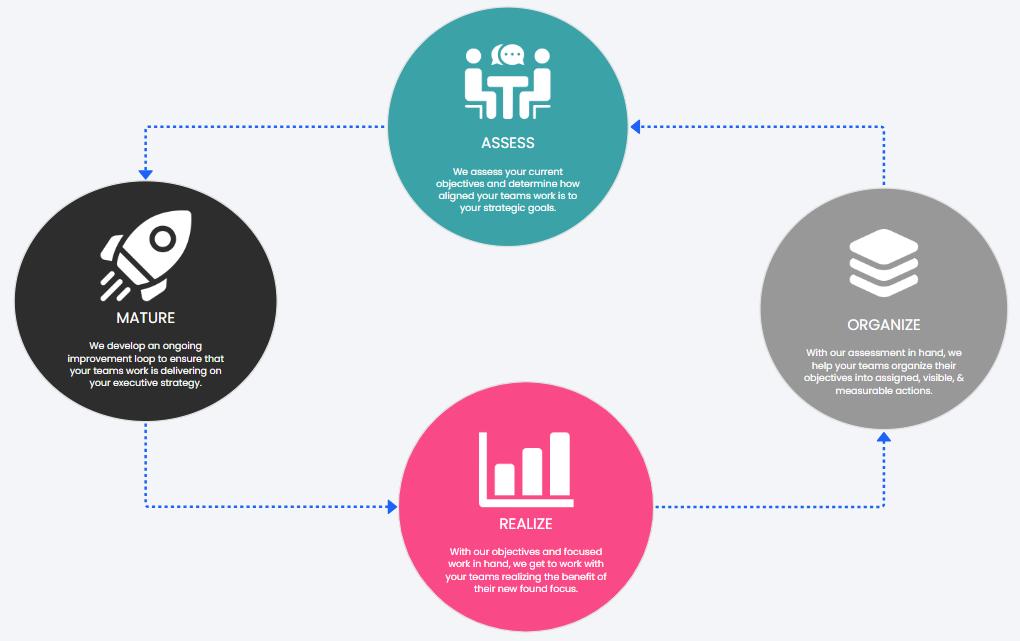How to Connect Strategy with Execution
“Strategy without process is little more than a wish list.” -Robert Filek

Strategy is vital to the growth of your business, but most companies and people struggle with focused, effective execution. It seems simple enough to follow through on a well-formed plan, however, it takes more than a desire for success to execute a strategy. Connecting strategy with execution begins and ends with people.
In this blog, we will discuss the three steps you and your team need to take with each strategy to achieve the desired results. The following steps are interdependent, complementary, and not without their challenges. However, with a strong team and clear goals, these steps will set you up to meet and exceed your goals every time.
Step One: Create Clarity and Buy-In Within Your Team
Execution begins during the development of strategy. When you engage subordinate leadership in the strategy development process, you have the opportunity to leverage the ‘collective genius’ of your organization and incorporate differing perspectives and intelligence. If you create the strategy in a vacuum, you risk decreasing the probability of success since you would be missing out on improved knowledge and the opportunity to consider varying perspectives.
By including your team in the strategy process, it also allows for a heightened sense of ownership that your team will possess for the project. If they have been involved from step one, they will be more invested in the outcome.
Clarity in communication is also vital in this process. Your team will be composed of individuals with varying learning styles and personality types. This will affect how information is processed. Don’t assume that your team knows or understands the strategy.
Concise and repetitive communication will ensure that the people who are executing understand the importance and prioritize their effort to execute in their roles most efficiently. We recommend that you utilize cascading messaging throughout the organization.
Finally, it’s important to count the costs and commit the appropriate resources. It’s unrealistic to expect success without effort or cost. If the strategy requires significant change, understand your people’s capacity for change and make adjustments where you need to — whether it be introducing new skill sets, technologies, or even changing the way you do business.
Once every member of your team is on the same page and committed to the strategy, it’s time to focus on action.
Step Two: Focus Your Execution
The strategy is set it’s time to let your team get to work. It may seem counterintuitive, but it’s important to decentralize your planning, execution, and decision-making. Equip, empower, and encourage your people and teams to complete the projects or activities that will lead to the desired results. This does not necessarily mean that there is no command and control, approval requirements, structure, or feedback mechanisms, but it does require you to trust your people and allow them to get the job done without micromanaging.
Remember, people generally only do one thing at a time very well. Do not saddle people with conflicting or extraneous initiatives or bog them down with unproductive work. Instead, ensure that those who are closest to the action and have the best view of the situation can do what is necessary to execute the strategy.
An important step in this process is to understand the current conditions. By ensuring that there is a realistic assessment of the current condition prior to execution, you are setting your team up for success with an informed approach. As your team executes, routinely reassess the current condition. This step also aids in keeping your execution as simple as possible to eliminate wasted effort, confusion, or conflict. A clear picture makes for concise execution.
The final key in the execution process is accountability from every member of the team – including yourself and other members of leadership. Start by setting up systems for action plans with well-defined measures and outcomes. Team members need to be able to effectively measure the results of their efforts as well as the activity that leads to the results.
This documentation not only keeps the project on track but is also a learning tool for future projects. You can assess what worked and what didn’t, any communication gaps, and possibilities for streamlining the process. We strongly encourage that feedback is given and taken in this period. Every team member has a voice and something to bring to the table and feedback is critical for improvement on all levels.
Step Three: Establish a Rhythm for Accountability
As mentioned above, accountability plays a critical role in the execution process. It seems simple to hold yourself and your people accountable to results, but to be effective, it must be intentional and routine. You can do this by establishing a rhythm for accountability.
First, establish clear expectations, the appropriate success measures, and an environment where your team can communicate freely. Start by creating a scorecard and review it routinely for each level of the organization. The meeting cadence should include daily stand-ups and weekly updates. Monthly and quarterly updates to different levels of leadership should be added as appropriate. These routine meetings should focus the effort on the most important activity to execute the strategy. As a team, you can use this time to identify unnecessary or unprosperous efforts and eliminate it or reevaluate the path forward.
These consistent check-ins will create a natural feedback mechanism. This feedback will allow you to continuously learn and adjust as the project moves forward. You may know where you are and where you want to go, but conditions do not always cooperate. Don’t be afraid to recognize a bad plan and scrap it. Sometimes, the fear of reputational damage can lock the whole team into a bad strategy. Be honest with yourself and your team and make changes as necessary. If you are consistently monitoring your actions and results, you can quickly learn and make adjustments that move your team toward the goal.
Above all, don’t accept mediocrity. If your team is committed and accountable, they will not accept mediocre results, poor performance, or bad behavior. Consistent communication will give your team the opportunity to express their questions, doubts, ideas, and passion about the project. Don’t miss out on the opportunity to have open and honest communication with your people through this process.
Connecting Strategy with Execution
Bridging the gap between strategy and execution is not merely a task of alignment, but a journey of integration and adaptation. By fostering clear communication, empowering teams, and embracing flexibility, organizations can effectively translate vision into action, driving sustainable growth and success. Remember, the true value lies not just in crafting brilliant strategies, but in the relentless pursuit of their execution, ensuring that every step taken propels the organization closer to its desired outcomes. To learn more about strategy execution, visit the Workfast Consulting website.


